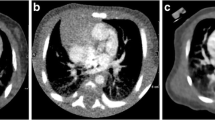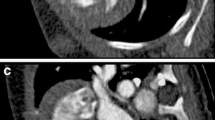Abstract
Background
Many technical updates have been made in multi-detector CT.
Objective
To evaluate image quality and radiation dose of high-pitch second- and third-generation dual-source chest CT angiography and to assess the effects of different levels of advanced modeled iterative reconstruction (ADMIRE) in newborns and children.
Materials and methods
Chest CT angiography (70 kVp) was performed in 42 children (age 158 ± 267 days, range 1–1,194 days). We evaluated subjective and objective image quality, and radiation dose with filtered back projection (FBP) and different strength levels of ADMIRE. For comparison were 42 matched controls examined with a second-generation 128-slice dual-source CT-scanner (80 kVp).
Results
ADMIRE demonstrated improved objective and subjective image quality (P < .01). Mean signal/noise, contrast/noise and subjective image quality were 11.9, 10.0 and 1.9, respectively, for the 80 kVp mode and 11.2, 10.0 and 1.9 for the 70 kVp mode. With ADMIRE, the corresponding values for the 70 kVp mode were 13.7, 12.1 and 1.4 at strength level 2 and 17.6, 15.6 and 1.2 at strength level 4. Mean CTDIvol, DLP and effective dose were significantly lower with the 70-kVp mode (0.31 mGy, 5.33 mGy*cm, 0.36 mSv) compared to the 80-kVp mode (0.46 mGy, 9.17 mGy*cm, 0.62 mSv; P < .01).
Conclusion
The third-generation dual-source CT at 70 kVp provided good objective and subjective image quality at lower radiation exposure. ADMIRE improved objective and subjective image quality.


Similar content being viewed by others
References
Achenbach S, Barkhausen J, Beer M et al (2012) Consensus recommendations of the German Radiology Society (DRG), the German Cardiac Society (DGK) and the German Society for Pediatric Cardiology (DGPK) on the use of cardiac imaging with computed tomography and magnetic resonance imaging. Röfo 184:345–368
Meinel FG, Huda W, Schoepf UJ et al (2013) Diagnostic accuracy of CT angiography in infants with tetralogy of Fallot with pulmonary atresia and major aortopulmonary collateral arteries. J Cardiovasc Comput Tomogr 7:367–375
Ou P, Celermajer DS, Marini D et al (2008) Safety and accuracy of 64-slice computed tomography coronary angiography in children after the arterial switch operation for transposition of the great arteries. JACC Cardiovasc Imaging 1:331–339
Walsh R, Nielsen JC, Ko HH et al (2011) Imaging of congenital coronary artery anomalies. Pediatr Radiol 41:1526–1535
Glöckler M, Halbfaß J, Koch A et al (2014) Preoperative assessment of the aortic arch in children younger than 1 year with congenital heart disease: utility of low-dose high-pitch dual-source computed tomography. A single-centre, retrospective analysis of 62 cases. Eur J Cardiothorac Surg 45:1060–1065
Han BK, Lesser AM, Vezmar M et al (2013) Cardiovascular imaging trends in congenital heart disease: a single center experience. J Cardiovasc Comput Tomogr 7:361–366
Yang JC, Lin MT, Jaw FS et al (2014) Trends in the utilization of computed tomography and cardiac catheterization among children with congenital heart disease. J Formos Med Assoc. doi:10.1016/j.jfma.2014.08.004
Tsai IC, Chen MC, Jan SL et al (2008) Neonatal cardiac multidetector row CT: why and how we do it. Pediatr Radiol 38:438–451
Paul JF, Rohnean A, Sigal-Cinqualbre A (2010) Multidetector CT for congenital heart patients: what a paediatric radiologist should know. Pediatr Radiol 40:869–875
Krishnamurthy R (2009) The role of MRI and CT in congenital heart disease. Pediatr Radiol 39:196–204
Krishnamurthy R (2010) Neonatal cardiac imaging. Pediatr Radiol 40:518–527
Al-Mousily F, Shifrin RY, Fricker FJ et al (2011) Use of 320-detector computed tomographic angiography for infants and young children with congenital heart disease. Pediatr Cardiol 32:426–432
Lee YW, Yang CC, Mok GS et al (2012) Infant cardiac CT angiography with 64-slice and 256-slice CT: comparison of radiation dose and image quality using a pediatric phantom. PLoS One 7, e49609
Zheng M, Zhao H, Xu J et al (2013) Image quality of ultra-low-dose dual-source CT angiography using high-pitch spiral acquisition and iterative reconstruction in young children with congenital heart disease. J Cardiovasc Comput Tomogr 7:376–382
Jin KN, Park EA, Shin CI et al (2010) Retrospective versus prospective ECG-gated dual-source CT in paediatric patients with congenital heart diseases: comparison of image quality and radiation dose. Int J Cardiovasc Imaging 26:63–73
Kim JE, Newman B (2010) Evaluation of a radiation dose reduction strategy for pediatric chest CT. AJR Am J Roentgenol 194:1188–1193
Huang MP, Liang CH, Zhao ZJ et al (2011) Evaluation of image quality and radiation dose at prospective ECG-triggered axial 256-slice multi-detector CT in infants with congenital heart disease. Pediatr Radiol 41:858–866
Pache G, Grohmann J, Bulla S et al (2011) Prospective electrocardiography-triggered CT angiography of the great thoracic vessels in infants and toddlers with congenital heart disease: feasibility and image quality. Eur J Radiol 80:e440–e445
Cheng Z, Wang X, Duan Y et al (2010) Low-dose prospective ECG-triggering dual-source CT angiography in infants and children with complex congenital heart disease: first experience. Eur Radiol 20:2503–2511
Han BK, Lindberg J, Overman D et al (2012) Safety and accuracy of dual-source coronary computed tomography angiography in the pediatric population. J Cardiovasc Comput Tomogr 6:252–259
Linet MS, Kim KP, Rajaraman P (2009) Children’s exposure to diagnostic medical radiation and cancer risk: epidemiologic and dosimetric considerations. Pediatr Radiol 39:S4–S26
Walsh MA, Noga M, Rutledge J (2015) Cumulative radiation exposure in pediatric patients with congenital heart disease. Pediatr Cardiol 36:289–294
Ghoshhajra BB, Lee AM, Engel LC et al (2014) Radiation dose reduction in pediatric cardiac computed tomography: experience from a tertiary medical center. Pediatr Cardiol 35:171–179
Meinel FG, Henzler T, Schoepf UJ et al (2015) ECG-synchronized CT angiography in 324 consecutive pediatric patients: spectrum of indications and trends in radiation dose. Pediatr Cardiol 36:569–578
Flohr TG, Klotz E, Allmendinger T et al (2010) Pushing the envelope: new computed tomography techniques for cardiothoracic imaging. J Thorac Imaging 25:100–111
Flohr TG, Leng S, Yu L et al (2009) Dual-source spiral CT with pitch up to 3.2 and 75 ms temporal resolution: image reconstruction and assessment of image quality. Med Phys 36:5641–5653
Lell MM, May M, Deak P et al (2011) High-pitch spiral computed tomography: effect on image quality and radiation dose in pediatric chest computed tomography. Invest Radiol 46:116–123
Brenner DJ, Hall EJ (2007) Computed tomography — an increasing source of radiation exposure. N Engl J Med 357:2277–2284
Brenner D, Elliston C, Hall E et al (2001) Estimated risks of radiation-induced fatal cancer from pediatric CT. AJR Am J Roentgenol 176:289–296
Huda W, Atherton JV, Ware DE et al (1997) An approach for the estimation of effective radiation dose at CT in pediatric patients. Radiology 203:417–422
Pearce MS, Salotti JA, Little MP et al (2012) Radiation exposure from CT scans in childhood and subsequent risk of leukaemia and brain tumours: a retrospective cohort study. Lancet 380:499–505
Mathews JD, Forsythe AV, Brady Z et al (2013) Cancer risk in 680,000 people exposed to computed tomography scans in childhood or adolescence: data linkage study of 11 million Australians. BMJ 346:f2360
Raff GL (2010) Radiation dose from coronary CT angiography: five years of progress. J Cardiovasc Comput Tomogr 4:365–374
McKnight CD, Watcharotone K, Ibrahim M et al (2014) Adaptive statistical iterative reconstruction: reducing dose while preserving image quality in the pediatric head CT examination. Pediatr Radiol 44:997–1003
Vorona GA, Ceschin RC, Clayton BL et al (2011) Reducing abdominal CT radiation dose with the adaptive statistical iterative reconstruction technique in children: a feasibility study. Pediatr Radiol 41:1174–1182
Vorona GA, Zuccoli G, Sutcavage T et al (2013) The use of adaptive statistical iterative reconstruction in pediatric head CT: a feasibility study. AJNR Am J Neuroradiol 34:205–211
Lee SH, Kim MJ, Yoon CS et al (2012) Radiation dose reduction with the adaptive statistical iterative reconstruction (ASIR) technique for chest CT in children: an intra-individual comparison. Eur J Radiol 81:e938–e943
Newell JD Jr, Fuld MK, Allmendinger T et al (2015) Very low-dose (0.15 mGy) chest CT protocols using the COPDGene 2 test object and a third-generation dual-source CT scanner with corresponding third-generation iterative reconstruction software. Invest Radiol 50:40–45
Mosteller RD (1987) Simplified calculation of body-surface area. N Engl J Med 317:1098
Ziegler A, Köhler T, Proksa R (2007) Noise and resolution in images reconstructed with FBP and OSC algorithms for CT. Med Phys 34:585–598
Wang G, Yu H, De Man B (2008) An outlook on X-ray CT research and development. Med Phys 35:1051–1064
Yu Z, Thibault JB, Bouman CA et al (2011) Fast model-based X-ray CT reconstruction using spatially nonhomogeneous ICD optimization. IEEE Trans Image Process 20:161–175
Bongartz G, Golding SJ, Jurik AG et al (2015) European guidelines on quality criteria for computed tomography. http://www.drs.dk/guidelines/ct/quality/index.htm. Accessed 18 Feb 2015
Deak PD, Smal Y, Kalender WA (2010) Multisection CT protocols: sex- and age-specific conversion factors used to determine effective dose from dose-length product. Radiology 257:158–166
Jadhav SP, Golriz F, Atweh LA et al (2015) CT angiography of neonates and infants: comparison of radiation dose and image quality of target mode prospectively ECG-gated 320-MDCT and ungated helical 64-MDCT. AJR Am J Roentgenol 204:W184–W191
Nie P, Wang X, Cheng Z et al (2012) Accuracy, image quality and radiation dose comparison of high-pitch spiral and sequential acquisition on 128-slice dual-source CT angiography in children with congenital heart disease. Eur Radiol 22:2057–2066
Kim JW, Goo HW (2013) Coronary artery abnormalities in Kawasaki disease: comparison between CT and MR coronary angiography. Acta Radiol 54:156–163
Acknowledgments
We thank our patients.
Author information
Authors and Affiliations
Corresponding author
Ethics declarations
Conflict of interests
None
Rights and permissions
About this article
Cite this article
Rompel, O., Glöckler, M., Janka, R. et al. Third-generation dual-source 70-kVp chest CT angiography with advanced iterative reconstruction in young children: image quality and radiation dose reduction. Pediatr Radiol 46, 462–472 (2016). https://doi.org/10.1007/s00247-015-3510-x
Received:
Revised:
Accepted:
Published:
Issue Date:
DOI: https://doi.org/10.1007/s00247-015-3510-x




